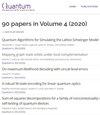神奇的3D颜色代码边界
IF 5.1
2区 物理与天体物理
Q1 PHYSICS, MULTIDISCIPLINARY
引用次数: 0
摘要
我们研究了三维颜色代码的边界,并将其系统地分类为101种不同的边界类型,包括两种新的边界类型。第一类由1个边界组成,通过将余维1 (2D) $T$ -畴壁扫过系统并将其附着在仅凝聚磁通量的$X$ -边界上而生成。由于$T$ -域壁不能在$X$ -边界上凝聚,因此产生了一个新的$\textit{magic boundary}$,其中边界稳定剂包含$XS$ -稳定剂,超越了传统的泡利稳定剂形式,因此包含“魔力”。无论是电激励还是磁激励都不能凝聚在这样一个神奇边界上,只有磁通量和余维-2 (1D) $S$ -畴壁的复合才能凝聚在这个神奇边界上,这使得这个神奇边界超越了拉格朗日子群的分类。第二类由70个边界组成,通过在codimension-1子流形上扫描$S$ -域壁并将其附加到边界上生成。这在交集处产生一个余维-2 (1D) $\textit{nested boundary}$。我们还将这些新边界与先前在$\mathbb{Z}_2^3$规范理论中发现的对应物连接起来,相当于三维环面代码的三个副本,其中$S$和$T$域壁对应于测量的对称保护拓扑(SPT)缺陷。只要SPT缺陷的相应对称性在边界上保持不变,就会产生新的边界。神奇边界的应用包括实现容错非clifford逻辑门,例如,在分形拓扑码的背景下。本文章由计算机程序翻译,如有差异,请以英文原文为准。
Magic Boundaries of 3D Color Codes
We investigate boundaries of 3D color codes and provide a systematic classification into 101 distinct boundary types, including two novel classes. The first class consists of 1 boundary and is generated by sweeping the codimension-1 (2D) $T$-domain wall across the system and attaching it to the $X$-boundary that condenses only magnetic fluxes. Since the $T$-domain wall cannot condense on the $X$-boundary, a new $\textit{magic boundary}$ is produced, where the boundary stabilizers contain $XS$-stabilizers going beyond the conventional Pauli stabilizer formalism, and hence contains 'magic'. Neither electric nor magnetic excitations can condense on such a magic boundary, and only the composite of the magnetic flux and codimension-2 (1D) $S$-domain wall can condense on it, which makes the magic boundary going beyond the classification of the Lagrangian subgroup. The second class consists of 70 boundaries and is generated by sweeping the $S$-domain wall across a codimension-1 submanifold and attaching it to the boundary. This generates a codimension-2 (1D) $\textit{nested boundary}$ at the intersection. We also connect these novel boundaries to their previously discovered counterpart in the $\mathbb{Z}_2^3$ gauge theory, equivalent to three copies of 3D toric codes, where the $S$ and $T$ domain walls correspond to gauged symmetry-protected topological (SPT) defects. New boundaries are produced whenever the corresponding symmetry of the SPT defect remains unbroken on the boundary. Applications of the magic boundaries include implementing fault-tolerant non-Clifford logical gates, e.g., in the context of fractal topological codes.
求助全文
通过发布文献求助,成功后即可免费获取论文全文。
去求助
来源期刊

Quantum
Physics and Astronomy-Physics and Astronomy (miscellaneous)
CiteScore
9.20
自引率
10.90%
发文量
241
审稿时长
16 weeks
期刊介绍:
Quantum is an open-access peer-reviewed journal for quantum science and related fields. Quantum is non-profit and community-run: an effort by researchers and for researchers to make science more open and publishing more transparent and efficient.
 求助内容:
求助内容: 应助结果提醒方式:
应助结果提醒方式:


